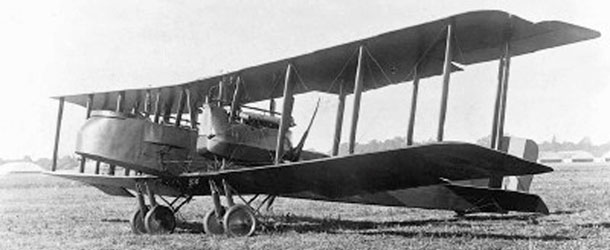After the preview of the Caproni Ca.3, it’s time to learn something more about the Gotha G.V, the German aircraft that will be featured, together with the Ca.3, in the Wings of Glory WWI Special Packs.
This heavy bomber was used by the "Luftstreitkräfte" - Imperial German Air Service – and entered in service in 1917, taking part in the ‘Operation Türkenkreuz’ – a series of bombing raids against England that caused panic among the civilian population, setting the stage for the German strategic campaign to bring the experience of the war to the British citizens.
The Gotha Bombers were produced since autumn of 1916, when the limitations of the Zeppelin as a raider had become obvious, and the raids over England had become too dangerous for German crews. The development of the Gotha IV (G.IV) changed this, as it was capable of flying for 500 miles at about 80 mph, if the weather was favorable. Gotha G.IV and G.Vs carried out 22 raids on England, dropping 83 tons of bombs with a loss of 61 aircrafts. In spite of their size and weight, they were agile and difficult to shot down. Anti-aircraft fire and bad landings accounted for more losses than attacks by enemy aircrafts.
The Gotha G.V was made in wood and steel and had two Mercedes engines and a wingspan of over 77 feet (23 meters). It could carry more than 1,000 pounds (454 kilograms) of bombs and was armed with 2 or 3 Parabellum MG14 machine guns. All bombs were carried externally.
Based on the Gotha G.IV, the G.V didn’t offer improved performance over it, but it was safer. The landing accidents caused 75% of operational losses on the G.IV, which had the fuel tanks into the engine nacelles - in a crash landing the tanks could rupture and spill fuel onto the hot engines. The G.V housed its fuel tanks in the center of the fuselage and the smaller engine nacelles were mounted on struts above the lower wings. In April 1918, 36 G.Vs were in service.
The crew of a Gotha G.V included the pilot and two gunners. The pilot seat was offset to starboard with the bomb bay immediately behind. This position allowed for a connecting walkway on the port side, allowing crew members to move between the three gun stations. An important innovation in the form of a "gun tunnel" whereby the underside of the rear fuselage was arched, allowing placement of a rearward facing machine gun protecting from attacks from below, removing the blind spot.
In 1918, improvements to the G.V resulted in the production of the G.Va and G.Vb, both of which were equipped with biplane horizontal stabilizers and twin vertical fins and rudders.
Bombing raids over England

The Gotha G.V 670/16, piloted by Walter Aschoff, at Mariakerke aerodrome. Credit: La Grande Guerre Culture Forum
The ‘Operation Türkenkreuz’ started on May 25th 1917, with a daylight raid that involved 21 G.IVs. The target was London, but due the weather conditions the plans were changed to attack a secondary target – Folkestone and the nearby army barracks at Shorncliffe on the Kent coast. In this raid, 95 people were killed and 195 injured. On their return journey, one G.IV was shot down. The G.IV had one major weakness – it had no way of defending from an attack from below, as its machine guns could not cover the area under its fuselage. As a result, any G.IV was highly vulnerable.
On June 5th, a second raid took place over the Isle of Sheppey, in Kent, without big effects on its fortifications, built to protect the naval base at Chatham. But a third attack, on June 13th was much more effective for the German purpose of bringing the war at home for British people, reaching London. In the single most deadly aerial raid of WW1, 162 people were killed, and 432 injured. The 21 Gotha bombers returned to their bases without loss, and the raid showed how unprepared London and the southeast coast was against an aerial attack.
A second attack on London was launched on July 7th, but this time Londoners did not stand in the streets to watch. This raid accounted for 54 deaths and 190 injured, and one G.IV was shot down and other three were damaged, while one British fighter was lost.
Daylight raids continued in August, but precautions against them were improved. For this reason, ‘Operation Türkenkreuz’ turned to night-time raids. While this gave protection from fighters and more protection against anti-aircraft fire, it brought its own problems – navigation and landing – especially dangerous due to the G.IV design with fuel carried in engine compartments.
On May 19th 1918, 38 Gotha G.Vs performed the largest raid of ‘Operation Türkenkreuz’ against London, but suffered heavy losses – 6 G.Vs were lost to RFC fighters and another one crashed on landing. With a loss rate nearing 20%, the raids were called off and the G.V’s concentrated their efforts on the Western Front.
The Gotha in Wings of Glory

The Gotha G.V KZ, initials of von Korff and von Zeidlitz, captured on March 21st 1918. Credit: Hubert Sermont Collection (www.baha.be).
The Gotha G.Vs presented in the Wings of Glory WWI Special Packs are two aircrafts from Kagohl 3, the unit formed in late 1916 to bomb England, , with the nickname "England Geschwader”.
The Gotha G..V number 670/16, of Oberleutnant Walter Aschoff, is recognizable by a serpent painted along the fuselage. The other G.V released is identified by the sign “KZ”, the initials denoting Lieutenant von Korff and Lieutenant von Zedlitz.
Walter Aschoff was born in April 1892. He was a pilot and observer during WW1, serving in the Kasta 18, the Kogohl 3, and later in Bosta 17, and flew in several bombing raids over England. He also wrote a book about the campaign, “Londonflüge 1917. Der Kampf des ersten Englandgeschwaders. Aus dem Fliegertagebuch”.
During the Third Reich, until about 1940, Aschoff served as an Oberleutnant in the Reichsluftfahrtministerium and later in the rank of an Oberst and commanding officer of the Flughafenbereichs Kommando 22/XI in Brüssels until 1943. At the end of the war he was imprisoned in Belgium and died at the age of 53, in 1946.
The Gotha G.V KZ was commanded by the Lieutnants Michael von Korff and Eberhard von Zedlitz und Neulich, from Bosta 16, who were captured on March 21st 1918 along with their gunner Gefreiter Willi Speier by the Belgian Armed Forces.
Information sources: The Aerodrome, Century of Flight, History Learning Site - Operation Turkenkruez, WWI Aviation, Wikipedia, La Grande Guerre Culture Forum.










Follow Us on